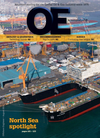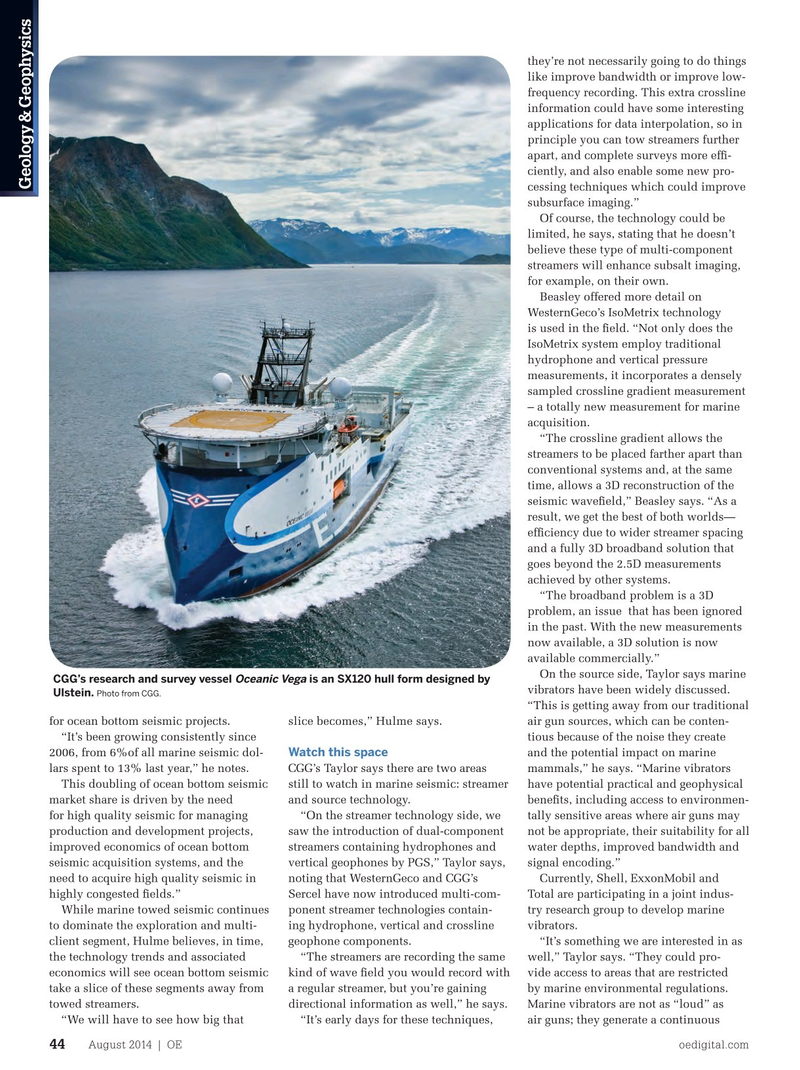
Page 42: of Offshore Engineer Magazine (Aug/Sep 2014)
Read this page in Pdf, Flash or Html5 edition of Aug/Sep 2014 Offshore Engineer Magazine
they’re not necessarily going to do things signal that has a lower peak intensity. like improve bandwidth or improve low- “According to a recent study made for frequency recording. This extra crossline the joint industry research group, this information could have some interesting would allow a smaller marine mammal applications for data interpolation, so in exclusion zone,” Taylor says.
principle you can tow streamers further
Non-seismic technologies apart, and complete surveys more eff- ciently, and also enable some new pro- Hobbs says there are a number of non-
Geology & Geophysics cessing techniques which could improve seismic technologies that TGS is monitor- subsurface imaging.” ing, and one of those is electromagnetic
Of course, the technology could be (EM) technology. limited, he says, stating that he doesn’t “We’ve been active investors in the believe these type of multi-component Barents Sea off Norway, along with streamers will enhance subsalt imaging, EMGS—the EM specialist in the indus- for example, on their own. try,” Hobbs says. “I think it is a valid
Beasley offered more detail on tool, in certain types of geology. We’re
WesternGeco’s IsoMetrix technology focused on identifying the areas where is used in the feld. “Not only does the it works and where it is synergistic with
IsoMetrix system employ traditional our seismic activities. hydrophone and vertical pressure “You can interpret seismic without measurements, it incorporates a densely EM, but it is almost impossible interpret sampled crossline gradient measurement EM without seismic.” – a totally new measurement for marine Hobbs says TGS will continue to invest acquisition. in EM where the company has a very “The crossline gradient allows the strong seismic database that can be used streamers to be placed farther apart than in conjunction with interpreting and conventional systems and, at the same processing EM data.
time, allows a 3D reconstruction of the
A compressed future seismic wavefeld,” Beasley says. “As a result, we get the best of both worlds— Beasley is excited effciency due to wider streamer spacing about what the future and a fully 3D broadband solution that holds for the goes beyond the 2.5D measurements geophysical industry. achieved by other systems. Beasley said “The broadband problem is a 3D compressive problem, an issue that has been ignored technology caused a
Craig Beasley in the past. With the new measurements big stir in the now available, a 3D solution is now medical imaging feld and could be available commercially.” revolutionary for seismic acquisitions.
On the source side, Taylor says marine He says where it might be advanta-
CGG’s research and survey vessel is an SX120 hull form designed by
Oceanic Vega vibrators have been widely discussed. geous to put out more sensors for acquisi-
Ulstein.
Photo from CGG.
“This is getting away from our traditional tions, more may not be required. Beasley for ocean bottom seismic projects. slice becomes,” Hulme says. air gun sources, which can be conten- says with compressive technology you “It’s been growing consistently since tious because of the noise they create have to be smarter about the complexity
Watch this space 2006, from 6%of all marine seismic dol- and the potential impact on marine of the thing you are trying to measure. He lars spent to 13% last year,” he notes. CGG’s Taylor says there are two areas mammals,” he says. “Marine vibrators relates the technology to how compres-
This doubling of ocean bottom seismic still to watch in marine seismic: streamer have potential practical and geophysical sion revolutionized the music industry market share is driven by the need and source technology. benefts, including access to environmen- by taking music compressed on compact for high quality seismic for managing “On the streamer technology side, we tally sensitive areas where air guns may discs (CDs) and compressing further into production and development projects, saw the introduction of dual-component not be appropriate, their suitability for all MP3 fles, which allow for more storage improved economics of ocean bottom streamers containing hydrophones and water depths, improved bandwidth and without noticeable loss in quality.
seismic acquisition systems, and the vertical geophones by PGS,” Taylor says, signal encoding.” “A more fundamental question would need to acquire high quality seismic in noting that WesternGeco and CGG’s Currently, Shell, ExxonMobil and be, did I need to make all those elaborate highly congested felds.” Sercel have now introduced multi-com- Total are participating in a joint indus- measurements to start with, if I could
While marine towed seismic continues ponent streamer technologies contain- try research group to develop marine simply compress with a factor of ten,” to dominate the exploration and multi- ing hydrophone, vertical and crossline vibrators. Beasley asked. “Couldn’t I have only client segment, Hulme believes, in time, geophone components. “It’s something we are interested in as sampled 1/10 of the data to start with? the technology trends and associated “The streamers are recording the same well,” Taylor says. “They could pro- That way you would save a lot in the economics will see ocean bottom seismic kind of wave feld you would record with vide access to areas that are restricted recording phase. It may not make that take a slice of these segments away from a regular streamer, but you’re gaining by marine environmental regulations. much sense for the digital media, but towed streamers. directional information as well,” he says. Marine vibrators are not as “loud” as for the seismic industry, this could be “We will have to see how big that “It’s early days for these techniques, air guns; they generate a continuous groundbreaking.”
August 2014 | OE oedigital.com 44 042_OE0814_G&G1.indd 44 7/22/14 5:37 PM

 41
41

 43
43